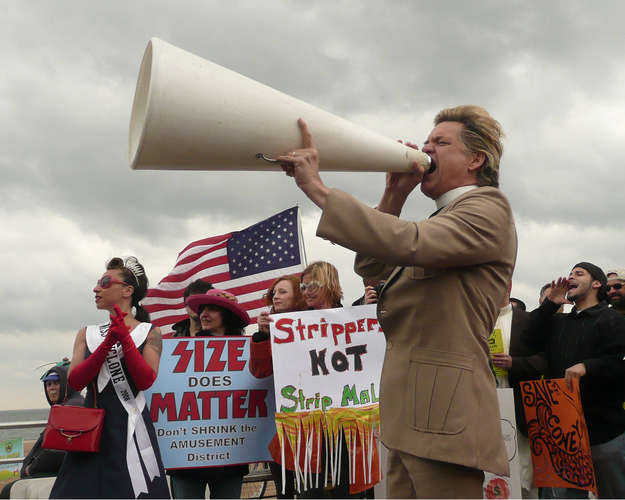
As it plays out on screen, no civic battle in recent New York history has been as contentious and passionate as the one between developer Joe Sitt and Mayor Michael Bloomberg for the future of Coney Island. The fight was the culmination of a complex tangle of zoning laws, neglect, tradition, class warfare, and lots and lots of money. Director Amy Nicholson's 77-minute documentary Zipper: Coney Island's Last Wild Ride, while not a definitive statement on the debate, is a fine start. The film, which had its world premiere on Saturday at the DOC NYC festival in New York City and screens again tonight (November 15), at the IFC Center in Manhattan, gives a voice to people unheard in the conflict—local residents and the amusement class.
 |
| Photo © Amy Nicholson The Zipper stands tall against a landscape of bulldozed amusements in Coney Island. |
In 2005, Sitt's Thor Equities unveiled a plan for a new Coney Island that called for businesses (Build-a-Bear Workshop), restaurants (Bubba Gump Shrimp Co.), housing (high-rise condos), and amusements (an indoor hotel water-park). Residents roundly decried the plan as a generic big-boxification of one of the nation's iconic communities and feared super-rich interlopers would push out working-class locals. The city countered Thor's plans with a few of their own, with the final version unveiled in 2009 designating 9.4 acres as parkland (down from the 60 acres Coney Island once had) for amusements but left the rest of Coney up for grabs.
Nicholson's film follows the fight in real-time (Zipper was shot over a four-year period) and frames the tug-of-war over Coney Island around the Zipper ride—a 56-foot-high oblong Ferris Wheel-like contraption that once swung thrill-seekers around an ovular track—as well as the ride’s owner, Eddie Miranda, and his tight-knight crew. This is a canny narrative strategy that elicits outrage as it puts a human face on the commodification of place.
One of the common overtures from Sitt and the politicians interviewed in the film is that this development is for the good of Coney Island and its residents. It will create much needed opportunity, jobs, and hope, they say. But as proponents claim that what’s missing from Coney is a Cold Stone Creamery and an Applebee’s, Nicholson cuts between their promises of low-wage homogenization and footage of Miranda and his friends dismantling their business, shuttering the parcel of land, and watching the Zipper as it is hauled off to its new home in Honduras. This is an undeniably bleak image—it becomes a gut-kick when we learn that one of Miranda’s grizzled carnival workers shed a tear during the dismantling, then chased after the truck that towed the ride away.
In capturing the end of the Zipper’s life, Nicholson has preserved a fragile moment in Coney Island’s history that is all but gone if you visit today. Numerous storefronts are still vacant, but many of the empty lots have been filled in with pristine new rides. One-time sideshows are now gift shops or takeaway restaurants, and blighted pavement has been given over to go-karts. Some of the old charm is gone—and the film suggests that more is sure to be lost as the city implements its plan to make the area into something like a Disnified Times Square on the Atlantic. Yet Coney Island endures.
The inevitability of cities is that they change. But the size, scope, and uniqueness of New York and its many mythic communities (like Coney) make any bout of urban evolution a particularly painful process. Zipper is an excellent document of how wrenching change can be.
Zipper: Coney Island's Last Wild Ride screens as part of the DOC NYC festival on Thursday at IFC Center at 3 p.m. and 9:30 p.m. Tickets are available on the DOC NYC website.

Post a comment to this article
Report Abusive Comment